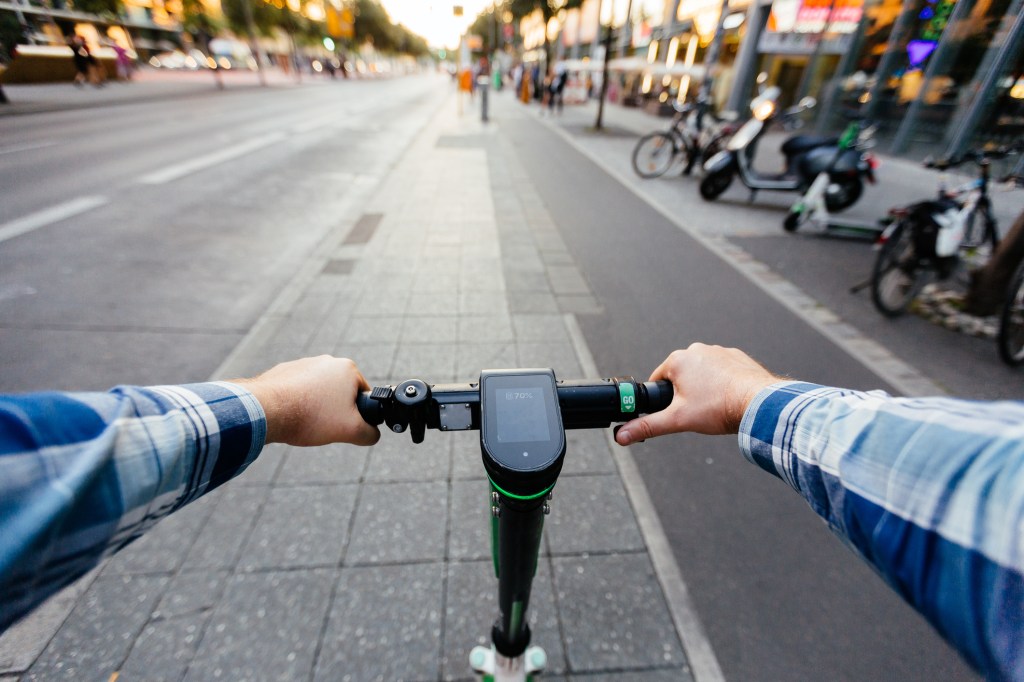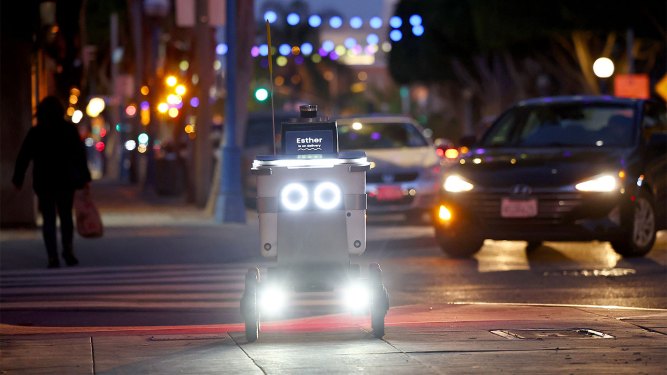The desire to achieve something as simple as keeping shared electric scooters off sidewalks has driven the development of some advanced technology in the micromobility industry. Once the province of geofencing, scooter companies are so eager to get a leg up on the competition that they’re now implementing technology similar to advanced driver assistance systems (ADAS) usually found in cars.
Operators like Spin, Voi, Zipp, Bird and Superpedestrian are investing in camera-based or location-based tech that can detect and even correct poor rider behavior, sometimes going to the extent of slowing scooters to a stop if they’re riding on a sidewalk.
People riding or parking scooters on sidewalks is a big problem for cities and forms one of the main complaints from NIMBYist residents who dislike change all the more when it becomes a tripping hazard. Companies are trying to solve this problem with tech that effectively puts the onus of rider behavior on operators, which may result in cities requiring scooter operators to have this sort of ADAS tech.
Scooter ADAS is probably the most doable and cost-effective method that cities can use to prevent unwanted rider behavior. And, it’s far cheaper than trying to police rider behavior themselves, or, address the lack of protected cycling infrastructure.
“This technology comes from a need for protected bike lanes,” said Dmitry Shevelenko, co-founder and president of Tortoise, an automated vehicle positioning service for micromobility companies. “It exists in this world where riders kind of have to do things that aren’t that great for others, because they have nowhere else to go. And so that’s the true driver of the need for this.”
Cities can solve this problem for the long term by building bike lanes or creating scooter parking bays, but until that happens, operators need to reassure local administrations that micromobility is safe, compliant and a good thing for cities.
“Until cities have dedicated infrastructure for whatever new modality comes to play, you have to figure out a way to use technology to make sure things don’t mix poorly,” said Alex Nesic, co-founder and chief business officer of Drover AI, a computer vision startup that provides camera-based scooter ADAS. “That’s really what we’re after. We want to enable this kind of maturation of the industry.”
Street views versus satellite views
Drover AI works with Spin, while Luna, another computer vision company, works with Voi and Zipp to attach cameras, sensors and a microprocessor to scooters to detect lanes, sidewalks, pedestrians and other environmental surroundings.
“Think of it as a secondary IoT module on the stem of the vehicle that does the computations via sensor fusion at the edge,” said Nesic. “The Drover system is looking for sidewalks, streets and bike lanes as separate categories, and it’s tracking the location and transitions between those locations. That’s shared with the onboard systems in real time, so latency is less than a second to implement sounds on board or speed control.”
Spin is piloting this tech with hundreds of devices in Milwaukee, Seattle, Miami and Santa Monica, and testing the ability to slow scooters to a stop. In the other markets, Spin’s vehicles issue a sound through the speakers that notify the rider to slow down or get off the sidewalk.
The scooters also share information via the cloud with Spin, resulting in a notification on the rider’s app a few seconds later explaining why the vehicle is beeping or has stopped. Luna’s tech is also capable of stopping the vehicle and is something Voi is considering exploring, in addition to an audible alert, in its pilot in Northampton.
Superpedestrian is taking a different approach to sensor fusion for rider behavior monitoring. The company recently acquired Navmatic, which helps micromobility operators locate vehicles and correct their movements in real time and is implementing a safety system called Pedestrian Defense.
Instead of extra hardware attached to scooters, Navmatic runs software on the scooters’ operating system, which also holds city maps. During a ride, data from sensors, such as vehicle direction, wheel speed and motion, is combined with GPS data to calculate the location and movements of the vehicle so precisely that Superpedestrian says it can detect sidewalk riding, poor parking, aggressive driver behavior and more.
Bird is taking a similar route to Superpedestrian but via an integrated sensor fusion chip in its newer scooters. The company, which recently began piloting the tech in Milwaukee and will soon be testing in San Diego as well, claims the solution will be less prone to errors and more reliable on more types of terrain.
Bird and Superpedestrian said they both chose to focus on location-based ADAS instead of camera-based because it’s cheaper and easier to scale. This approach accommodates technology that is available and viable today, while computer vision is still too immature and expensive, according to the companies.
“We’re glad to see a race to the top for pedestrian safety across the industry, but safety tech is only effective at protecting pedestrians when you can scale it across every scooter,” Paul White, senior director of public affairs at Superpedestrian, told TechCrunch. “The most practical and durable solutions are often the most cost-effective. We figured out how to make rider behavior safer without adding a lot of fragile, expensive and hard to integrate components. We can deploy our new Pedestrian Defense system fleetwide, and we can do it without altering our rates to customers, or cutting corners on labor, maintenance or service expansion in low-income communities.”
Nesic says Drover AI’s systems are 95% effective and they don’t need GPS, which can be unreliable, to function.
“Even in areas that have poor connectivity, because we’re edge-based, our system will function,” said Nesic. “Any GPS-based system has to have a clear understanding of what the infrastructure is, i.e., accurate mapping or HD mapping. And cities change rapidly, so what might have been a sidewalk a few months ago may not be a sidewalk now. Our system doesn’t require that kind of ground truth to function, so it’s much more nimble to adapting to new environments.”
Superpedestrian is GPS-based, but Navmatic’s tech can switch over to other sensors to ensure accurate positioning when GPS is unreliable, according to a company spokesperson. Whether Navmatic’s tech is that good, industry experts familiar with the deal say the acquisition was less about acquiring Navmatic’s IP, which was too niche to succeed on its own, and more about acquiring Navmatic’s staff, as Superpedestrian has a reputation for chasing down top talent.
The spokesperson also said Navmatic’s sensor fusion tech would lay the groundwork for future computer vision technology if the company decided to go in that direction one day.
The money going into scooter ADAS
The space hasn’t attracted massive amounts of money yet, but it’s newer than the shared scooter industry itself, so we’ll have to wait and find out how the use cases pan out. Luna raised seed funding of €400,000 ($470,000) this March, but is likely being paid for its services by Voi and Zipp. Voi in August raised $45 million, which it will put toward further research and development into technology to prevent sidewalk riding and parking, possibly in-house.
Nesic said Drover’s PathPilot tech was about two years in the making before the company was formed, but the startup has so far raised around $900,000 at a $5 million pre-money valuation.
“We paired that with a large pre-payment from Spin when we signed our first agreement and that’s how we’ve grown to date,” said Nesic. “We have grown the business to include multiple customers globally. We have received orders for quantities that take Drover to EBITDA positive once fulfilled.”
Nesic said Drover is also actively raising capital to meet accelerated demand from customers, but he wouldn’t go into further details.
Superpedestrian didn’t reveal the financial terms of its deal, but the people familiar with the transaction say it bought Navmatic for about $4 million.
Is it worth it for the operators?
Operators are really at the mercy of cities for permits, and the pressure is only going to rise if the competition starts doing something cities seem to like. It’s too early to tell if including such tech can help companies make money by winning more permits, how much the additional costs will cut into profits or what the potential savings can amount to.
The biggest expenses associated with running a shared micromobility business are overhead costs like insurance and fees, rebalancing, and recharging and vehicle maintenance. Attaching computer vision modules to scooters could cost about $100 to $200 in hardware per scooter, according to sources. Moreover, another part on a scooter means it has another part that can break, which probably doesn’t help with maintenance costs.
Nesic says despite the hardware cost and the monthly SaaS fee for Drover’s services, he expects the tech to save clients money in the long run. For example, if a scooter is parked in a garage, that’s a GPS black hole, which might lead to theft of the scooter or time and money spent looking for the unit. The camera-based system would be able to identify the location of the scooter based on images it picks up.
“Another one is parking violations,” said Nesic. “By having a camera on board, I can attach an actionable photo, good, bad or indifferent, at the end of every single ride, which helps the city manage things more proactively, helps the operator avoid fines in real time, and nudges the user to a better outcome.”
Fines are no joke. San Francisco’s MTA has been keeping track of cases of improperly parked scooters, for which it issues a fine of $100 each, and since November 2020, Lime has had over 3,800 cases, Scoot has had about 3,000, and Spin has had about 1,700.
Nesic also says there’s a chance scooter ADAS systems on vehicles can help lower insurance costs for operators, but experts feel it’s not that simple.
“From an insurer’s perspective, anything that decreases the probability of a claim and the magnitude of the loss affects the risk of the insurable event,” Mike Shim, co-founder and CEO of digital insurance company DigiSure, told TechCrunch. “So if the insurable event in this instance is property casualty and liability — damage or loss caused by an accident involving the insured (i.e., the renter) — and if onboard tech can reduce that risk, in theory it will affect the rating factor and reduce the price of the insurance.”
But these ratings aren’t adjusted instantaneously, and they adjust only after the insurer has collected and analyzed large volumes of claims data, which takes time.
“The problem with using this actuarial approach is that these models will only change over long arcs, say over decades,” continued Shim. “By that time, we’ll have autonomous flying taxis! So it doesn’t do much to help current scooter companies.”
Long-term bets on scooter ADAS
Some feel scooter ADAS is a meaningless safety feature that doesn’t impact operations much and is just one of the numerous requirements that make it harder for new companies to enter the space and costlier to expand. Given the climate crisis, any restrictions on zero-emissions mobility solutions can be a poor waste of resources, but this one may be here to stay.
“There are many examples of a snowball of certain expectations baked into the template regulations around a space, and it’s very hard to undo that, because cities will just copy each other,” said Shevelenko. “And then 20 years from now, we’ll have these requirements baked in and nobody will quite know why or how it started.”
The auto industry might provide some insights into what is likely to happen with scooter ADAS technology. In 2019, the European Commission announced a plan to ensure that all new cars in Europe and the U.K. would be fitted with devices to curb speeding by 2022. The technology needed to do this already exists, but politics has kept it out of cars historically.
The U.S. is generally slower on the uptake than Europe, but it’s not outside the realm of possibility. The bipartisan $1 trillion infrastructure bill currently being debated in the Senate has a provision that would require driver monitoring systems in cars to detect drunk driving and even intervene.
Recently, a drunken e-scooter rider using his own vehicle on a Birmingham motorway made news, which highlights the differences between geofenced shared models and seemingly limitless private ones. If scooter ADAS tech does become mainstream in the shared world, it stands to reason that it will also become standard on retail e-scooters and e-bikes as well — like how consumer drones are regulated with geofencing so they don’t fly where they shouldn’t.
Of course, it’s also possible that the tech turns out to be wildly unpopular among riders who don’t want to be infantilized, which will cause it to phase out. If that happens, companies like Drover AI and Luna can start pooling together their data and resources to help autonomous delivery robots improve their tech. Who knows?







